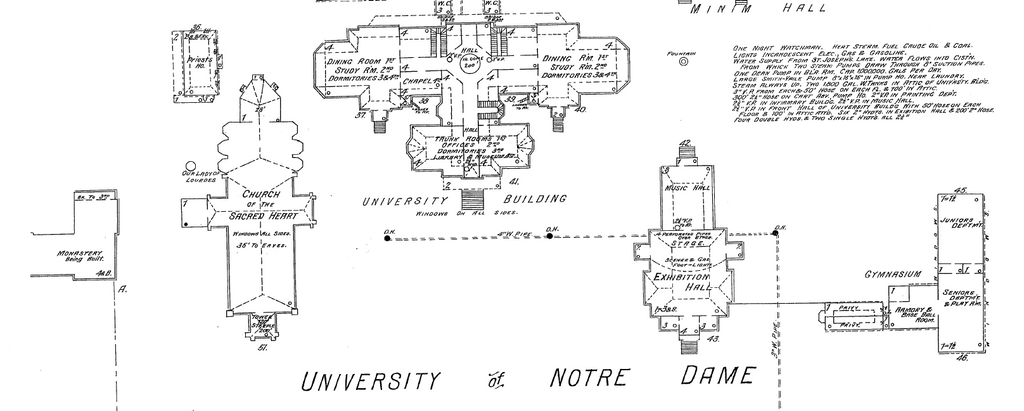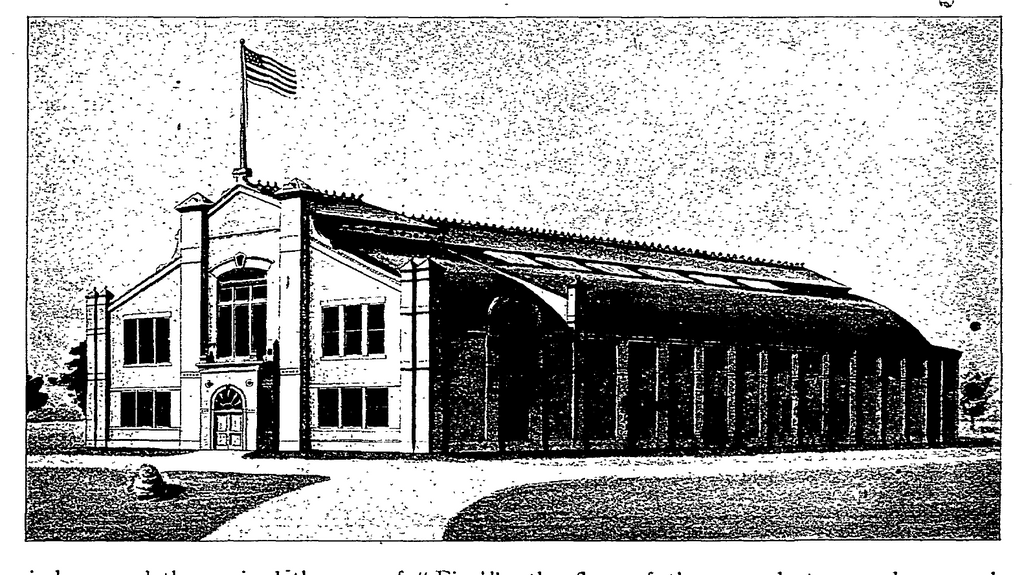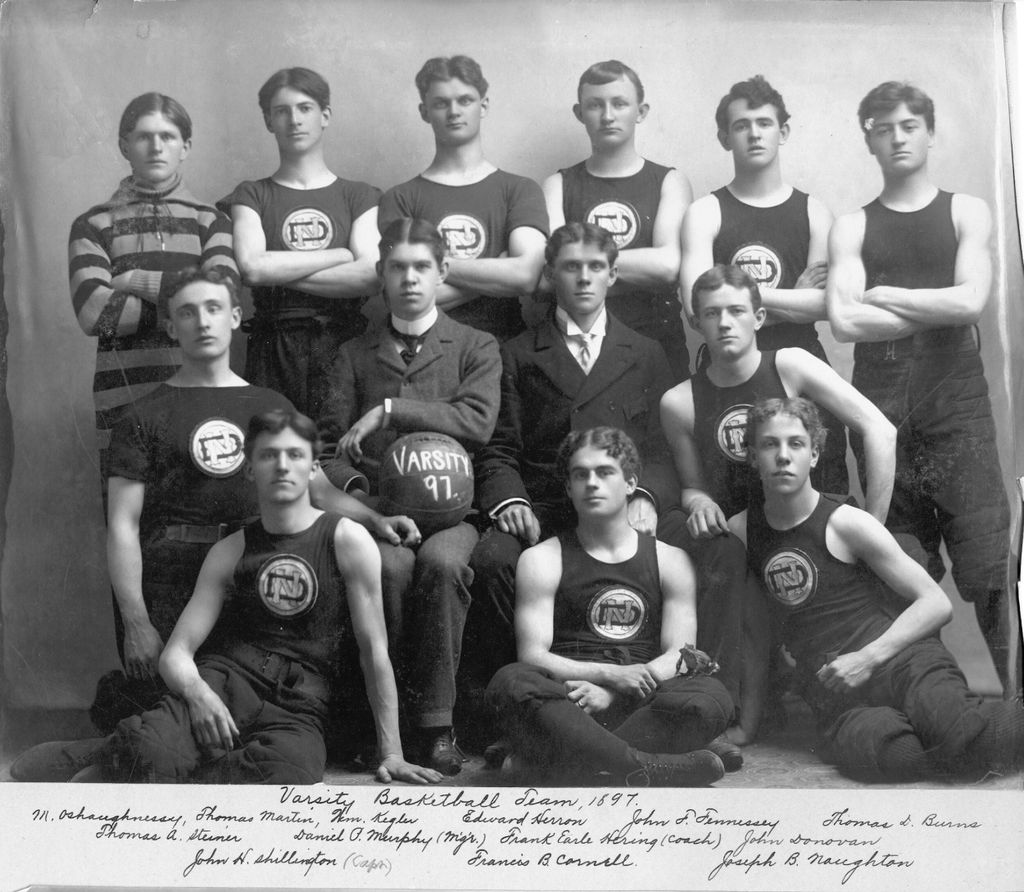The Birth Of Notre Dame Basketball
By Alan WasielewskiOriginally published March 31, 2020
When the University of Notre Dame men’s basketball team finished the truncated 2019-20 season with a victory over Boston College in the first round of the Atlantic Coast Conference tournament, it became the eighth college basketball program in the nation to win 1,900 games, a feat which, according to record books, took 115 seasons.
Or so we thought. That was the reality when the season began. However, more research has brought to light two previously undiscovered seasons, placing the Irish at 1,904 college basketball wins in 117 years of basketball.
Let’s review what we knew about the Notre Dame men’s basketball program entering the 2019-20 season. When a reader opens up the record book and turns to the season-by-season index, it begins with a loss to Chicago First Regiment on January 29, 1898, followed by a 19-13 loss to the Chicago Clybournes on February 5, 1898.
The Scholastic, a weekly student newspaper at Notre Dame, honored the effort of the team against the Clybournes in its update the following week.
Note: All copy from The Scholastic is shown as it would have been read in the original copy.
“The play was exciting and vigorous from the signal, the Varsity team playing with the determination that characterized the old team of last year.”
– The Scholastic, February 12, 1898
The old team of last year?
But the athletic department records show that the team began in 1898, under head coach Frank Hering and led by captain Martin O’Shaughnessy, and finished 1-2.
The Scholastic is the United States’ oldest continuously-published collegiate periodical. In the late 1890s, it was published weekly and was a recap of anything and everything that occurred among Notre Dame’s 650 students, at that time spread across six dormitories on the Northern Indiana campus.
It is the best and most accurate historical record of the University during this time frame. Logic dictates that if a team existed in 1897, The Scholastic would mention it.
And indeed it did.
“It is very probable that our basket-ball players will be pitted against some of the strongest teams in the middle West in the near future. Manager Murphy has already written to eight or 10 of the Indiana, Michigan and Illinois [sic], and it is very likely that a game will be played with one of these outside teams within the next few weeks. Although we have not been playing basket-ball as long as some of our neighboring colleges and athletic clubs, there is no reason why we should not be able to have a running team at Notre Dame. The skillful work already done in the various hall contests is very gratifying and there is promise of steady improvement.”
– The Scholastic, February 6, 1897
It would seem that there was in fact a Notre Dame varsity basketball team in 1897.
BASKETBALL EMBRACED QUICKLY ON CAMPUS
Less than six years after Dr. James Naismith nailed up two peach baskets in the Springfield, Massachusetts, YMCA on December 21, 1891, basketball had quickly spread across the nation and was particularly active in local YMCAs and college campuses.
The Young Man’s Christian Association (YMCA) began in the United Kingdom in 1851 and by the late 1890s served as the catalyst for the expansion of basketball across the United States. Any active collegiate team who adopted the sport in the 1890s would face local and regional YMCAs in their first non-intramural matches.
It is difficult to find a consensus on when and where the first collegiate basketball game was played. Geneva College in Beaver Falls, Pennsylvania, claims to have played the first game in February of 1892 while Vanderbilt competed against the local YMCA in February of 1893. Both of these contests were played with nine players aside.
In 1895, Hamline University and Minnesota A&M played the first intercollegiate match with 18 players on the court. The final ‘first’ was the intercollegiate match between teams featuring five players on each side, pitting the University of Chicago against Iowa on January 18, 1896.
At Notre Dame, Brownson, Carroll and Sorin Halls engaged in heated intramural matches that whet the appetite of the student body for more basketball competition.
Before they were ever known as the Fighting Irish, Notre Dame embraced an underdog mentality that would propel the school’s competitive teams in the early decades of the athletic department. That mentality motivated the student body to form its first varsity basketball team in 1897 – Charles Shillington, Francis Cornell, Edward Herron, Thomas Steiner and Joseph Naughton.
HOME COURT – CARROLL GYM
“New baskets have been placed in the Carroll gym for the game tonight. The change would be welcome one were it not for the fact that the Varsity men find some trouble in gauging their exact locations. They are placed higher than the others.”
– The Scholastic, March 27, 1897
The 1897 team called Carroll Hall ‘gym’ their home court. This building was located just north of the modern location of LaFortune Student Center, east of Washington Hall and just south of the current footprint of Cavanaugh Hall. It was no more than a large recreation room that would be cleared of equipment for the basketball contests.

A portion of the University of Notre Dame campus map as of 1893. The Carroll Hall ‘gymnasium’ can be seen in the lower right hand corner, adjacent to Washington Hall.
The Notre Dame Fieldhouse arrived for the following basketball season and was hailed by The Scholastic as a modern venue for the burgeoning hoops program.
“And what a fine place it is for a basket-ball game when compared with the little old court in the Carroll Hall recreation room where the games of other years were played! The audience is not compelled to double their feet up in under them in order to make room, and the players are not smashing into a brick wall about every time they turn around.”
– The Scholastic, February 28, 1899
Unfortunately, a fire destroyed the first edition of the Fieldhouse in 1899 and pushed the basketball program into mothballs until 1907-08.

The original Notre Dame Fieldhouse – as shown in The Scholastic, which burned down in 1899.
Or did it? Before we dive into the second season of Notre Dame basketball, we need to reflect on the first.
THE FIRST VARSITY GAME
“When the supple, well-built band of young men had come from Fort Wayne to play our newly organized Varsity basketball team stepped upon the floor of Carroll “gym” on Wednesday night, the hearts of many of our “rooters” were filled with misgivings.
The misgivings were short lived, however for scarcely three minutes of play had elapsed when Shillington tossed a goal from the field and from that on it was plain sailing for Notre Dame. Shillington threw two more goals, and then Cornell began an exhibition of goal tossing that caused every one, from the dignified men with the mortar-boards down to the smallest Minim, to strain his vocal cords to the utmost.”
– The Scholastic February 27, 1897
In 1897, what we now regard as field goal attempts, or shot attempts, were known as ‘throws.’

Box score of the first Notre Dame men’s basketball varsity game, as shown in The Scholastic.
There was no dribbling. You were allowed to move but once you caught or possessed the ball, you could not move.
Peach baskets were still being used at this point (metal hoops would start being used consistently in the early 1900s) and it is unclear whether the bottom was cut out of them or if they had to retrieve the ball after each point. Some peach baskets at the time were smaller in diameter than the balls being used, so even if the basket had the bottom cut out each team would use a pole to poke the ball back out of the basket.
Notre Dame ‘threw’ in 13 goals in its first game against the Fort Wayne YMCA, earning the program’s first win 26-13. There was just a single foul committed in the contest (by Charles Shillington, who goes in the record book as the first person to score for Notre Dame and commit a foul) and one ‘goal from foul’ – a free throw – converted by Fort Wayne.
The game drew over 250 spectators and a trip to Fort Wayne for a second game would be quickly agreed to by both teams after the contest.
Varsity basketball had begun at the University of Notre Dame.
“Immediately after the basket-ball game between the Varsity Five and the Fort Wayne YMCA last week, one of the Fort Wayne students telegraphed to a young lady friend, announcing the victory of the Varsity. The telegram was received by the young lady during a meeting of a local social society. Filled with patriotism for Notre Dame, the girls gathered around the instrument and, after announcing the victory, gave the college yell in tones demonstrative of their delight.”
– The Scholastic, March 6, 1897

The 1897 Notre Dame Varsity Basketball Team.
A CONTROVERSIAL END TO THE SEASON
The trip to Fort Wayne on March 18, 1897, provided Notre Dame with a 2-0 start to its varsity basketball program (21-5 victory), and the team organizers reached out to the Chicago Central YMCA to complete a three-game schedule.
“The Central YMCA basket-ball team will be down from Chicago tonight to play the Varsity men. The team from Chicago has a clean record of victories won from the best clubs in the Windy City. Notre Dame knows a trick or two in basket-ball, and has lost no games. Query: When two irresistible forces meet what is the result? Why-er-a-why, an excellent game of basket-ball between Central YMCA of Chicago and the Notre Dame Varsity.”
– The Scholastic, March 27, 1897
While The Scholastic and indeed the entire campus looked forward to the visit from the Chicago Central YMCA, the contest was marred by a somewhat familiar modern issue with fans and coaches alike – officiating.
“The Varsity undoubtedly would have won had the officials been impartial; but the two Chicago umpires wanted their men to win, and they seemed to do all in their power to help their team to victory.”
– The Scholastic April 3, 1897
An officiating crew in the early days of basketball consisted of a referee and two umpires. The referee was responsible for keeping the score, putting the ball in play and ruling if the ball was in or out of bounds. The umpires were responsible for calling the fouls. In this game, both of the umpires were from the Central YMCA team, while the referee was Notre Dame head coach Frank Hering.
How bad was the officiating from The Scholastic’s point-of-view?
“Notre Dame forged ahead by steady, skillful playing and kept ahead by a small margin all through the game until the last four or five minutes of the ‘third.’ About this time the umpires began to call fouls repeatedly on the Varsity and totally ignore the fouls and unnecessary roughness of the Chicago team. This naturally discouraged our men.”
– The Scholastic, April 3, 1897
The fouls allowed Chicago to take control of the contest with free throws and forced Notre Dame to stop the game and demand to have an official with home team ties serve as one of the umpires. Chicago would only agree if they were in turn given the referee position. Both teams were at an impasse and the game ended early with Chicago claiming a protested 25-22 victory.
ANOTHER VARSITY SEASON FOUND
How long was the men’s basketball team sidelined after 1897? The official athletic department records currently list 1907-08 as the return season (and the Irish have played every season since), but further research shows that an impromptu varsity season was added in 1902.
There were three varsity teams that competed at a high level for Notre Dame in 1901-02. The track team was coming off five consecutive state championships (a gathering of the top collegiate teams in the state) and in March of 1902, easily defeated Indiana and Purdue in a triangular meet, scoring more points than the Hoosiers and Boilermakers combined.
The baseball team swept through their 1902 season with a 7-0-1 record against in-state teams (Wabash, Indiana, DePauw and Purdue) with a rain-shortened eight-inning tie with Purdue proving to be the only blemish.
In the fall of 1901, the Notre Dame football team finished 8-1-1 under coach Pat O’Dea and team captain Al Fortin. Victories over Purdue and Indiana and a season-ending victory over the South Bend Athletic Club that avenged a season-opening tie to the same team established Notre Dame as the best team in Indiana.
Notre Dame’s athletic teams were bursting with confidence and looked to pursue another state title in basketball.
“Since we are champions in football, baseball and track work we seek the same honour in basketball. The qualifications of the members of the team have been passed on and the team has been given the standing of any of the athletic teams in the University.”
– The Scholastic, February 22, 1902
Six players drew the assignment to represent the 1902 Notre Dame Varsity basketball team. Philip O’Neill, James Doar, James Barrett, Louis Salmon, Dominic Groogan and John Quinlan played three warm up games in total, one at the Indianapolis YMCA (a 42-22 loss with the team affected by playing on the ‘polished floor and not be accustomed to play in a net’) and two victories in Anderson, Indiana, against that town’s YMCA (29-23, 22-11).
The Notre Dame six set their eyes on Purdue, purported to be the best team in the state, and booked the game at a neutral site in Logansport, Indiana.
“Purdue, for some reason not entirely plain, cancelled the date at Logansport, and the Commercial College of that city was substituted. Our fellows were in superb physical condition, and were always anxious to play, but their opponents couldn’t stand the fast, pace and were continually “killing time.” The score which ended in a tie, 15-15, does not show the relative merits of the teams, as our fellows outplayed them at every point, but had “hard luck” with their baskets and the officials.”
– The Scholastic, February 22, 1902
Notre Dame’s second varsity basketball season would end with a 2-1-1 record.
Over the next five years, Notre Dame would shift back to a focus on intramural basketball and the university would not field a varsity basketball team until 1907-08. Brownson and Carroll Halls’ intramural teams even played teams from outside the University, but no team would be called ‘varsity’ until 1907.
1,905 WINS
Moving forward, the athletic department archives will be updated to include the missing two years of varsity action. The record will now reflect that Notre Dame in fact won its first varsity basketball game. A fitting start for one of the country’s winningest programs.






